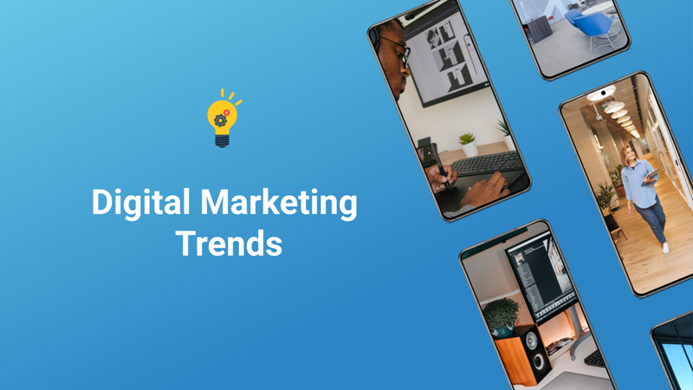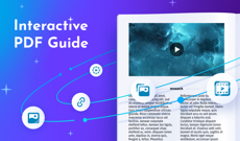The growth of digital marketing has skyrocketed over the past two years as many businesses spent their time creating innovative digital customer-friendly experiences.
Now, it’s the best time for companies to look at what they have achieved and decide how they can optimize all those changes to retain customers and keep up with the latest trends. There’s a delicate balance between highly digital trends, such as Artificial Intelligence (AI) and Augmented Reality (AR), on the one hand and the most human ones, like inclusivity and diversity, on the other. In our article, we’ve tried to cover both of these tendencies.
#1 AI Marketing
Artificial intelligence marketing (AI Marketing) is a method of leveraging customer data and AI concepts like machine learning to anticipate your customer’s next move, improve their journey, and retain loyal clients. AI can help build more effective marketing strategies and change the way businesses attract, nurture, and convert prospects.
Here are some of the goals that various AI tools can help you achieve:
- Improve personalization and recommendations: Top digital transformation companies leverages AI to improve personalization and recommendations, resulting in a more tailored and relevant customer experience. AI enables you to predict customer behavior based on intelligence gathered from previous brand interactions. Thus, you can send marketing and sales collateral that’s most likely to convert a lead into a sale at the best possible time to drive conversions.
- Adopt customer service chatbots: many companies are now programming chatbots to deal with common customer queries and provide instant replies at any time of the day or night. This reduces the customer service time and lifts the workload, leaving the agents free to deal with conversations that need a more personal response.
- Enhance advertising: businesses can target potential clients easier using AI digital marketing and machine learning as AI gathers data from users, analyzes it, and forecasts future behavior. Such data helps brands create target advertising based on the user's choices.
#2 Interactive Content
Interactive content is one of the fastest-growing digital marketing trends nowadays. In 2026, we’ll be seeing a further shift from traditional content toward dynamic, engaging one that offers users an immersive experience, such as:
- Quizzes and polls
- Flipbooks
- Interactive infographics
- Embedded calculators
- Augmented reality ads
- 360-degree videos
For instance, check out how fresh and engaging an interactive flipbook can look.
6 reasons to make a PDF interactive
Create yours
People love interactive content not just because it’s fun and captivating but also because it makes them feel more connected to the brand they are using. So this trend has an infinite amount of opportunities and ways to grow and become the most popular among others.
#3 Video Marketing
As demand for interactive content keeps growing, video marketing will continue to evolve in the future as well. Check out the hottest video marketing trends for 2026:
- Shoppable videos: such videos feature products with embedded links. The viewers can click on the links, learn more about the products, and purchase them right away—all without having to leave the video. You can create shoppable videos on social media platforms like Instagram and Facebook and connect them to your eCommerce website. Moreover, by integrating text to speech technology, you can add engaging voice overs to your shoppable videos, enhancing the viewer's experience.
- Live video streaming: in the past two years video became the preferred way to consume new content, especially when people started spending more time at home. Social platforms will continue to be the key source of live video content where brands and influencers can reach a wider audience. This is a great way for businesses to create human, authentic, and relatable video content and connect with their customers.
- Short-form videos: according to Wyzowl, 73% of customers prefer learning about a product or service by watching short-form videos. And 88% said those videos had convinced them to take out their wallets and try a new product or service. And if your video is just under the one-minute mark, the viewer engagement will be at its highest.
#4 Conversational Marketing
Conversational marketing is a customer-centric and dialogue-driven approach to marketing. It has become a go-to strategy for driving customer engagement, improving customer experience, and growing revenue. Nowadays, many businesses use the WhatsApp Business Platform for this purpose and provide an unlimited experience to customers with WhatsApp chat.
While many brands have gone digital during the past few years, they certainly haven't become artificial. Because now, perhaps even more than ever, people are looking for live interactions with others. There’s nothing that beats the sense of empathy and efficiency you get from speaking to a real human in real-time.
Email is no longer the cornerstone of B2B and B2C communications—live chats and phone/video calls are. Using conversational marketing is a great way to reimagine your inbound and outbound channels. For instance, try your hand at hybrid events, customized demos, or personalization through artificial intelligence (AI).
#5 Green Marketing
Green marketing (also known as sustainable marketing, eco-marketing, and environmental marketing) is an advertising strategy marketers can apply to environmentally friendly brands, products, or services.
Some eco-friendly practices a company might employ include pairing their waste disposal with a recycling program, making the switch to renewable energy, going digital, or sourcing renewable materials for manufacturing processes. Adopting such practices, aka ‘going green’, can help companies achieve environmental sustainability. And then they can carry the message to their customers, creating a better world together and attracting a more eco-conscious audience. It can also increase brand loyalty and boost your brand image.
At FlippingBook, we have a green initiative of our own. Anyone can get featured on our website and we will plant a tree for you to help global reforestation! Ask us how to participate.
#6 Inclusivity and Diversity
Inclusivity and diversity no longer belong exclusively to the HR world. In 2026 and beyond, it’s the job of the whole company to elevate and promote diversity in all of its forms, strengthen connections with customers, and foster a culture of positive social change.
Just make sure it’s not all rooted in performance and advertising. The best practices of diversity are backed with inclusive hiring practices, neutral language (don’t use too much slang or complicated terms), and even donations or investments in organizations that help uplift diverse communities. Here are just a few ways how brands can make their marketing more inclusive:
- Use inclusive language: make sure all messaging is free from slang, references, or other verbiage that discriminates against a group of people. Inclusive language should be a priority not only for your marketing, but for your job descriptions, website copy, and communication among employees.
- Choose your visuals carefully: visuals are one of the most important factors when it comes to digital advertising. Photos, graphics, and videos are a way to instantly hook the viewer and make them want to know more and feel connected to what they see. When creating any visual content, always consider such factors as race, gender, age, ability, and socioeconomic status of your audience.
- Celebrate beyond the usual holidays: it’s common to create social media content and marketing promotions around major holidays, seasons, and other events. You can do better—highlight your brand’s inclusive mindset by celebrating or acknowledging holidays focused on various diverse groups.
That’s it! The top digital marketing trends for 2026 that we’ve found the most exciting and promising. Some of these trends might be easier for your business to hop onto than others. And you can note the other ones as general directions to keep an eye on. Just remember that in the end, it all comes to a genuine human connection and authenticity. That’s what really matters.





